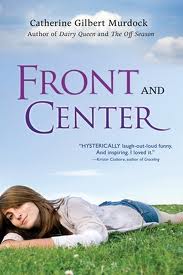Does FRONT AND CENTER live up to its DAIRY QUEEN predecessors?
 In three earlier posts (November 1st and 9th, and December 9th, 2012) I wrote about some great middle grade and YA books that outdoorsy/sporty girls might really love, all of which I discovered have sequels I’d not known about but would’ve been eagerly awaiting and looking out for if I had. When I found out these books had sequels, I immediately bought them, and I’ve read them all now so I’ll give a review of each starting here and continuing in the next couple posts. It’s hard for books to live up to such high expectations…
In three earlier posts (November 1st and 9th, and December 9th, 2012) I wrote about some great middle grade and YA books that outdoorsy/sporty girls might really love, all of which I discovered have sequels I’d not known about but would’ve been eagerly awaiting and looking out for if I had. When I found out these books had sequels, I immediately bought them, and I’ve read them all now so I’ll give a review of each starting here and continuing in the next couple posts. It’s hard for books to live up to such high expectations…
First, Front and Center, of Catherine Gilbert Murdock’s Dairy Queen series (which would appeal to girls who enjoy sports, football and basketball in particular. Books in this series include, in order, Dairy Queen, The Offseason, and now, Front and Center):
I just love the character of D.J.Schwenk. She may be my favorite main character ever. She’s charmingly funny and awkward–humble, honest, insecure, a character just waking up to and beginning to own her talents, to feel comfortable in her skin as a girl, a female. She’s not the world’s greatest student, but she’s far from dumb and works hard at school. Due to her athletic talents, leadership qualities, and physical size (height and strength), she finds herself in the limelight without even wanting to be there. She hates all the attention. She’s clumsy around adults, clumsy with boys, clumsy expressing herself verbally, confused and clumsy when it comes to her own emotions. She’s grown up on a Wisconsin dairy farm with football-star older brothers and a dad who’s treated her much the same as them, so she’s a little rough around the edges, thinks she has to be emotionally tough, that she’s not like other girls. She’s amazed that boys could find her attractive, doubts she could be seen as pretty or feminine. But she enjoys the attention of the boys, and she likes them (in fact she’s confused about which of two boys she likes more), and there is romance in the book, but the kind of romance I can stomach in YA–no sex. She’s amazed that Division I college coaches are recruiting her–in basketball. In the previous books in the series, football is the sport most focused on, but in this book, it’s basketball. The author did a great job of making the sports action sound realistic. Before reading the afterward at the end of the book, I thought she must’ve played basketball herself at a fairly high level–it rang that true–but by what she’s written in the afterward, it appears she just did her research well.
Anyway, I love this book as much as the two in the series that came before it, possibly even more because it’s about basketball, which was my sport. I give it a 4.9 out of 5 stars. Funny thing about this book and the others in the series: I didn’t think the plot of any of them was their strength. Or maybe it’s just that when I saw their cover art and read the jacket flap on each story, I wasn’t sure I was going to be interested in them even though they were being touted as sports stories. Football? Eh. Romance in YA? Ugh, always awkward IMHO. And I’ve already mentioned in a previous post how the cover art for these books seems to be going after mass appeal rather than reflecting the true spirit of the stories. Simply put, I loved these books because of the main character, D.J. Schwenk. Catherine Gilbert Murdock could write just about anything with D.J. as the protagonist, and I bet I’d love it no matter what the story was about, or how strongly-plotted. I care about D.J. I want to hear what she has to say, how she reacts to things. She makes me smile and laugh and feel like, yes, I know, me, too. I wouldn’t have felt so alone in the world as a kid if I’d had these books to read. Heck, I feel less alone as a grown adult.
So please write more, CGM! The story where D.J. is a freshman in college sounds great; I’ve written a story about a girl going on to play college basketball as well (but which doesn’t fall into a neat category, age-wise, for marketing/shelving purpose), so please pave the way and show that there is interest in such a transitional type YA story! It appears I’m not the only one who finds D.J. Schwenk so endearing; if you read the author comments at the back of the book, she tells of the great volume of fan mail she received from readers asking for more of D.J., whereas she’s not had the same reaction to the main characters of her other books. That shows what a beloved character D.J. is.


